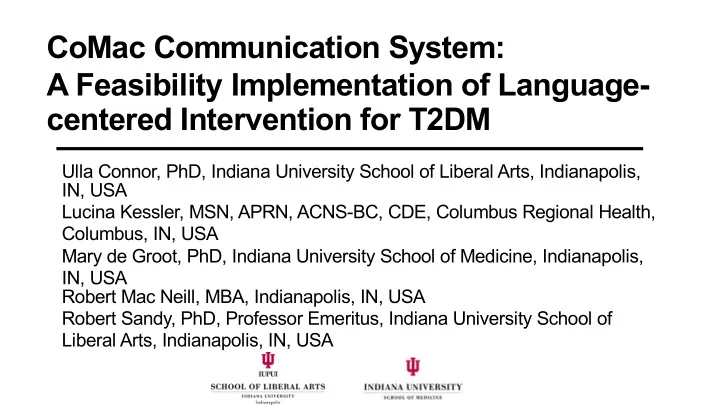

CoMac Communication System: A Feasibility Implementation of Language- centered Intervention for T2DM Ulla Connor, PhD, Indiana University School of Liberal Arts, Indianapolis, IN, USA Lucina Kessler, MSN, APRN, ACNS-BC, CDE, Columbus Regional Health, Columbus, IN, USA Mary de Groot, PhD, Indiana University School of Medicine, Indianapolis, IN, USA Robert Mac Neill, MBA, Indianapolis, IN, USA Robert Sandy, PhD, Professor Emeritus, Indiana University School of Liberal Arts, Indianapolis, IN, USA
Presenter and Co-Author Disclosures • Ulla Connor, Ph.D. – CSO, CoMac Analytics, Inc. • Lucina Kessler, MSN, APRN, ACNS-BC, CDE - none • Mary de Groot, Ph.D. – Faculty, Johnson & Johnson Diabetes Institute, Inc., Consultant, Eli Lilly, Inc. • Robert Mac Neill, MBA – CEO, CoMac Analytics, Inc. • Robert Sandy – Principal, CoMac Analytics, Inc.
Problem and Need • Increasing burden of diabetes management • Patient numbers, costs, limited HCP time and resources (Economic Costs of Diabetes in the U.S. in 2017, ADA) • Need for better tools for patient engagement, individualization, and focus on language for effective population management. (Standards of Medical Care in Diabetes - 2018, ADA) (Psychosocial Care for People with Diabetes: A Position Statement of the ADA, 2016)
Can Linguistics Help? • Linguistically-based CoMac Segmentation and Communication System • Segments patients according to their worldviews and perceptions (Connor, et al., 2005) • Predicts adherence (Sandy and Connor, 2015) • Person-centered communication strategies to match the HCP talk with patient talk (Bartlett Ellis, et al., 2014)
Background Linking Patient Language with Psychosocial Constructs (Connor, et al., 2011; Connor and Lauten, 2014) Psychosocial Construct Examples from Transcript Excerpt Agency (Bandura, 1977) • High (takes charge) “I take my medications constantly.” • Low (does not take charge) “I hate to take the medicines; there are too many side effects.” Affect (Martin and White, 2005) • Positive (upbeat) “I absolutely think that I can manage it.” • Negative (discouraged) “I’m frustrated most of the time.” Control Orientation (Rotter, 1966) • Internal (looks to self) “I intend to lick this thing [diabetes].” • External (looks to others) “Unfortunately I’m a sweetaholic. If they didn’t make sweets, I probably wouldn’t be diabetic.”
Background Translating Linguistic Research into Practice • Developing a segmentation tool: 12-question survey, The Descriptor (Connor, et al., 2015) • Linking segments to reported adherence (Sandy and Connor, 2015) • Developing and testing communication strategies for HCPs (Bartlett Ellis, et al., 2014)
Output to Clinicians 1. Segmentation 3. Wording Options 2. Communication Strategies
Study Aims 1. Assess the feasibility of integration of the CoMac System to clinical practice 2. Assess the impact of the intervention implementation on health outcomes
Methodology and Design • Mixed methods implementation trial in a Midwestern regional health system clinic, April - December 2016, implemented by a community health worker and two diabetes educators as part of a regular clinical practice. The data were natural clinic observation data. • Patient participant criteria for the analysis • Initial assessment • Initial goal setting • One or more follow-up visits at least 30 days after initial visit • Pre- and post-A1C measures • 120 participants with type 2 diabetes over 18 years of age • 72 patient participants in the CoMac intervention • 48 patients in naturally occurred control group with no CoMac intervention
Results: Baseline Characteristics Characteristic CoMac Intervention Control P -value (N=72) (N=48) • Age in years, MEAN (SD) 61.5 (13.0) 62.4 (13.0) 0.720 • Start weight in lbs, MEAN, (SD) 224.7 (48.6) 221.7 (74.7) 0.792 • Start A1C, MEAN, (SD) 9.02 (2.1) 8.2 q(1.4) 0.015 • Gender 0.881 • Male 34 22 • Female 38 26
Results: Feasibility of Integration into Clinical Practice • Methods: analysis of field notes, interviews, monthly site visits • Results • System implementable • Segmentation survey quick and feasible • Patient Profile, Points of Emphasis, and Linguistic Cues • Effective counseling time • Patient-centered strategic intervention • Standardized engagement • Effective resource allocation
Results: Change in A1Cs Regression Output with A1C Change as Dependent Variable Variable Coef. Std. Err. t P -value A1C start -0.70 0.06 -10.90 0.000 CoMac Intervention -0.42 0.23 -1.81 0.037 Age 0.01 0.01 1.12 0.266 Start weight 0.00 0.00 1.10 0.274 Male -0.10 0.23 -0.42 0.678
Conclusion • Study demonstrated the feasibility and effectiveness of the CoMac Segmentation and Communication System in Diabetes Education. • Showed statistically significant A1C level reduction of the intervention group • Future studies to include randomized trials, expand sample size, and clinical settings “Words matter; you can bet your health on it.”
Thank You! www.liberalarts.iupui.edu/icic/ www.comacanalytics.com Acknowledgements The basic linguistic research reported in this presentation was supported by the Eli Lilly and Company Foundation (2007-2010).
Recommend
More recommend